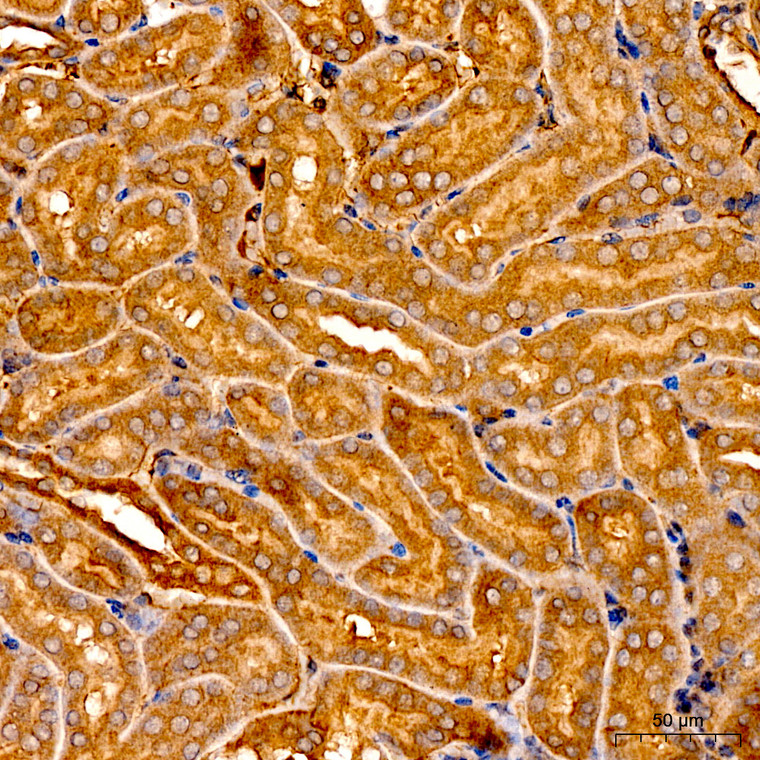| Host: |
Rabbit |
| Applications: |
WB/IHC |
| Reactivity: |
Human/Mouse/Rat |
| Note: |
STRICTLY FOR FURTHER SCIENTIFIC RESEARCH USE ONLY (RUO). MUST NOT TO BE USED IN DIAGNOSTIC OR THERAPEUTIC APPLICATIONS. |
| Short Description: |
Rabbit polyclonal antibody anti-LPCAT3 (200-487) is suitable for use in Western Blot and Immunohistochemistry research applications. |
| Clonality: |
Polyclonal |
| Conjugation: |
Unconjugated |
| Isotype: |
IgG |
| Formulation: |
PBS with 0.01% Thimerosal, 50% Glycerol, pH7.3. |
| Purification: |
Affinity purification |
| Dilution Range: |
WB 1:500-1:1000IHC-P 1:50-1:200 |
| Storage Instruction: |
Store at-20°C for up to 1 year from the date of receipt, and avoid repeat freeze-thaw cycles. |
| Gene Symbol: |
LPCAT3 |
| Gene ID: |
10162 |
| Uniprot ID: |
MBOA5_HUMAN |
| Immunogen Region: |
200-487 |
| Immunogen: |
Recombinant fusion protein containing a sequence corresponding to amino acids 200-487 of human LPCAT3 (NP_005759.4). |
| Immunogen Sequence: |
GPQFSMNHYMKLVQGELIDI PGKIPNSIIPALKRLSLGLF YLVGYTLLSPHITEDYLLTE DYDNHPFWFRCMYMLIWGKF VLYKYVTCWLVTEGVCILTG L |
| Tissue Specificity | Highly expressed in liver, pancreas and adipose tissue. Very low expression in skeletal muscle and heart. Detected in neutrophils. |
| Function | Lysophospholipid O-acyltransferase (LPLAT) that catalyzes the reacylation step of the phospholipid remodeling process also known as the Lands cycle. Catalyzes transfer of the fatty acyl chain from fatty acyl-CoA to 1-acyl lysophospholipid to form various classes of phospholipids. Converts 1-acyl lysophosphatidylcholine (LPC) into phosphatidylcholine (PC) (LPCAT activity), 1-acyl lysophosphatidylserine (LPS) into phosphatidylserine (PS) (LPSAT activity) and 1-acyl lysophosphatidylethanolamine (LPE) into phosphatidylethanolamine (PE) (LPEAT activity). Favors polyunsaturated fatty acyl-CoAs as acyl donors compared to saturated fatty acyl-CoAs. Has higher activity for LPC acyl acceptors compared to LPEs and LPSs. Can also transfer the fatty acyl chain from fatty acyl-CoA to 1-O-alkyl lysophospholipid or 1-O-alkenyl lysophospholipid with lower efficiency. Acts as a major LPC O-acyltransferase in liver and intestine. As a component of the liver X receptor/NR1H3 or NR1H2 signaling pathway, mainly catalyzes the incorporation of arachidonate into PCs of endoplasmic reticulum (ER) membranes, increasing membrane dynamics and enabling triacylglycerols transfer to nascent very low-density lipoprotein (VLDL) particles. Promotes processing of sterol regulatory protein SREBF1 in hepatocytes, likely by facilitating the translocation of SREBF1-SCAP complex from ER to the Golgi apparatus. Participates in mechanisms by which the liver X receptor/NR1H3 or NR1H2 signaling pathway counteracts lipid-induced ER stress response and inflammation. Down-regulates hepatic inflammation by limiting arachidonic acid availability for synthesis of inflammatory eicosanoids, such as prostaglandins. In enterocytes, acts as a component of a gut-brain feedback loop that coordinates dietary lipid absorption and food intake. Regulates the abundance of PCs containing linoleate and arachidonate in enterocyte membranes, enabling passive diffusion of fatty acids and cholesterol across the membrane for efficient chylomicron assembly. In the intestinal crypt, acts as a component of dietary-responsive phospholipid-cholesterol axis, regulating the biosynthesis of cholesterol and its mitogenic effects on intestinal stem cells. |
| Protein Name | Lysophospholipid Acyltransferase 5Lplat 51-Acylglycerophosphocholine O-Acyltransferase1-Acylglycerophosphoethanolamine O-Acyltransferase1-Acylglycerophosphoserine O-AcyltransferaseLysophosphatidylcholine AcyltransferaseLpcatLyso-Pc AcyltransferaseLysophosphatidylcholine Acyltransferase 3Lyso-Pc Acyltransferase 3Lysophosphatidylserine AcyltransferaseLpsatLyso-Ps AcyltransferaseMembrane-Bound O-Acyltransferase Domain-Containing Protein 5O-Acyltransferase Domain-Containing Protein 5 |
| Database Links | Reactome: R-HSA-1482788Reactome: R-HSA-1482801Reactome: R-HSA-1482839 |
| Cellular Localisation | Endoplasmic Reticulum MembraneMulti-Pass Membrane Protein |
| Alternative Antibody Names | Anti-Lysophospholipid Acyltransferase 5 antibodyAnti-Lplat 5 antibodyAnti-1-Acylglycerophosphocholine O-Acyltransferase antibodyAnti-1-Acylglycerophosphoethanolamine O-Acyltransferase antibodyAnti-1-Acylglycerophosphoserine O-Acyltransferase antibodyAnti-Lysophosphatidylcholine Acyltransferase antibodyAnti-Lpcat antibodyAnti-Lyso-Pc Acyltransferase antibodyAnti-Lysophosphatidylcholine Acyltransferase 3 antibodyAnti-Lyso-Pc Acyltransferase 3 antibodyAnti-Lysophosphatidylserine Acyltransferase antibodyAnti-Lpsat antibodyAnti-Lyso-Ps Acyltransferase antibodyAnti-Membrane-Bound O-Acyltransferase Domain-Containing Protein 5 antibodyAnti-O-Acyltransferase Domain-Containing Protein 5 antibodyAnti-LPCAT3 antibodyAnti-MBOAT5 antibodyAnti-OACT5 antibody |
Information sourced from Uniprot.org
12 months for antibodies. 6 months for ELISA Kits. Please see website T&Cs for further guidance









